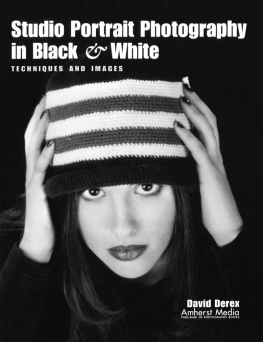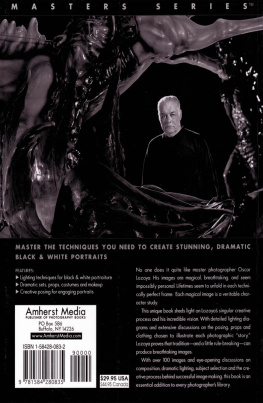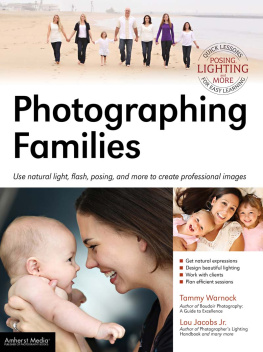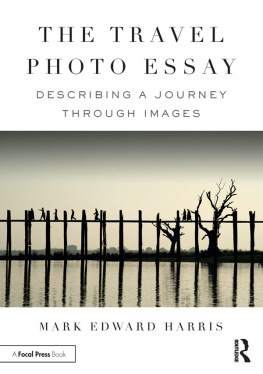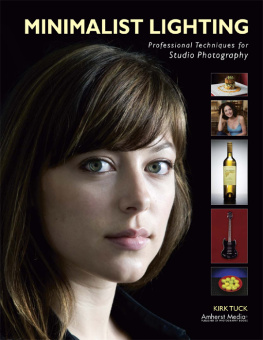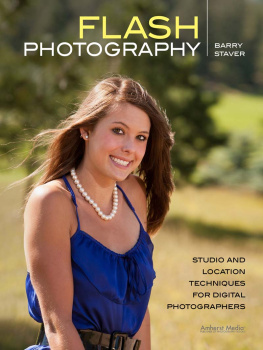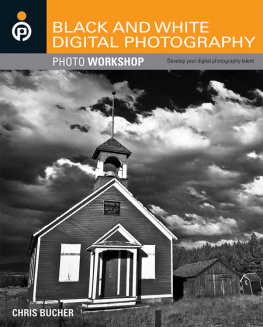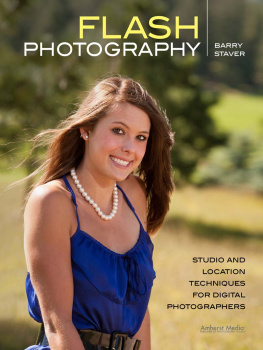I dedicate this book
to Bub, (Rose Klayman, 18911974), who, although sightless, showed us how to always see only the best in everyone. My grandmothers presence in our home was truly a blessing.
to my father, Ben Derex (1918-1996), whose exemplary life was a delicate blend of passion, strength and tenderness. His brightness was my beacon, guiding me on a clear course.
to my mother, Florence Derex, for her caring, compassion, and unconditional love. The nurturing environment that she impeccably maintained has made everything possible.
to my brother, Michael Derex, for the great times, wonderful shared memories, and always being there for me. His many talents, sensitivity and humility are a source of inspiration.
with love, honor, respect and gratitude
Copyright 2000 by David Derex
All rights reserved.
Published by:
Amherst Media, Inc.
P.O. Box 586
Buffalo, N.Y. 14226
Fax: 716-874-4508
Publisher: Craig Alesse
Project Manager: Michelle Perkins
Senior Editor: Frances Hagen Dumenci
Assistant Editor: Matthew A. Kreib
Illustrations by: Michelle Perkins
ISBN: 1-58428-029-8
Library of Congress Card Catalog Number: 99-76591
Printed in the United States of America.
10 9 8 7 6 5 4 3 2 1
No part of this publication may be reproduced, stored, or transmitted in any form or by any means, electronic, mechanical, photocopied, recorded or otherwise, without prior written consent from the publisher.
Notice of Disclaimer: The information contained in this book is based on the authors experience and opinions. The author and publisher will not be held liable for the use or misuse of the information in this book.
Table of Contents
About the Author
In 1966, I was studying English literature and liberal arts at the University of Illinois, but had no clear plans for the future. Many of my friends were writers, artists, filmmakers and musicians. Through these associations, the idea that photography might be my personal art form entered my consciousness.
My father had a pawnshop on Chicagos South Side, and having worked there on Saturdays as a teenager, I remembered seeing cameras occasionally becoming available for sale. I asked my dad to keep his eye out for a 35mm with a built-in light meter, and shortly thereafter he presented me with a Yashica rangefinder, featuring a 50mm f 1.8 lens.
After acquiring a rudimentary understanding of photography and camera operation (f -stop, shutter speed, depth of field), I practiced shooting around campus, and in the streets of Chicago. I bought a bulk film loader, empty cassettes, and a few one-hundred-foot rolls of Panatomic-X and Tri-X. A hand-rolled, 36-exposure cassette of black & white film cost me thirty-five cents!
During the summer of 67, I traveled around Mexico producing my first photo essays and environmental portrait studies. There was a naturalness to my relationship with the camera from the beginning. I had found my art form. It combined my love of people, travel and creative self-expression. My mission was to produce social documentary, slice of life images that captured the human condition.
Relating to people with my camera seemed a part of me that was always there, but not realized. There was a new opportunity to approach strangers, like forming a creative alliance.
The following semester, I registered for Photography 101, in the Fine Arts Department, with Art Sinsabaugh. We were required to master view cameras and needed to prove that we could properly expose and develop 4x5 film, and make contact prints with classical print quality, before we were allowed to make enlargements.
A classic, black & white print contains a rich black, pure white, and a full range of gray tones. This is one of the standards by which gallery prints are judged. I am grateful to have had this training.
Apart from a respect and appreciation for the craft of photography, the main thing I remember from Sinsabaugh was his mantra, Shoot from the gut. I agree with that philosophy. Powerful photographic art is a combination of solid technique and a passionate, personal vision.
From the very beginning, from age twenty, I was a photographer. I had found my path. It was never a hobby or amateur pastime for me. There was seriousness in my approach and in my relationship to the work from the very first year.
After college, I continued my street photography mostly in Chicago and during frequent trips to New York City.

My Professional career commenced in 1971. I began shooting model portfolios for schools and agencies all around the country, and I named my company dukeamerica.
During the seventies, I continually traversed the highways and air corridors of the United States, eventually working in most of the major cities and in a few minor outposts as well. I photographed literally tens of thousands of subjects of every size, age and shape imaginable. It was not uncommon to shoot a thousand frames a day, and on a few occasions, I may have exceeded the two thousand mark. This experience was of phenomenal value to me and prepared me well for the years to come.
By 1978, I had been on the road for seven years and was ready for a change of pace. I craved new creative challenges. New York City was the art and cultural Mecca and it beckoned to me. I was eager to pit myself against the best photographers in the world. This was the great proving ground.
My first New York studio was on the Lower East Side, and from this colorful location, I catered mostly to models and actors. In 1980, I opened a spacious loft studio on West 35th Street, in the teeming Garment District. I began cultivating a mixed bag of people photography clients, fulfilling assignments for the fashion and beauty industries, the music business, public relations and advertising agencies, and entertainment magazines.
The myriad of interesting, glamorous and accomplished subjects have included athletes, dancers, singers, actors, centerfold models, and politicians.
In recent years, my portraits have enjoyed a growing popularity, as both commercial and consumer audiences have come to appreciate the power and the greatness of this magnificent art form.
Portraits are amazing. For the subject, they are a declaration to the world, I am here! For families, there is sharing, bonding, nurturing, celebrating and building self-esteem. A portrait can become a treasured heirloom, a valued part of ones history to bequeath as a legacy, a vital link to the future.
I am blessed to be able to contribute to peoples lives, and Im very grateful that my portraiture provides me the opportunity to generate beauty, harmony and love.
Images & Techniques
Lori was lying on a crushed velvet fabric which was draped over a carpeted area in my studio. This material served to provide a comfortable surface for her to work on, as well as to coordinate nicely with the soft texture of her dancers stretch garment.
The lighting was positioned so as to very specifically interpret the facial features. Notice how the dramatic lighting delineates the strong angularity of the nose, cheekbone and jawline, yet also accents the round and soft shapes of the eyes and lips.
In this instance, Lori was stationary while I moved all around her, shooting from various camera angles and heights. Compositionally, the brighter tones of the image (skin) carve a bold diagonal across the darkness of the background and garment, and the (imaginary) line drawn through the eyes intersects this with another strong diagonal.

